Portadown FC Roll of Honour
07/01/2022 - 2.20
Trevor Clydesdale

Portadown War Memorial. Source: Author's Collection
Great War Roll of Honour
Private James Lamb: Service Number 4626, 1st Battalion Royal Irish Fusiliers
James Lamb of 27 Foundry Street enlisted in County Donegal and served gallantly for almost four years.
A report in the Portadown News on 11th December 1915, informed us that “Private James Lamb, Edenderry, has been home on a few days leave, after spending fourteen months in France and Flanders. He was with the R.I.F in all the fierce engagements, and was buried for three hours in a trench which was blown up by a German shell.”
Almost a year later on 11th November 1916, the Portadown News had further information on James. “Private James Lamb, Edenderry, has reached Portadown from the front for four weeks leave. He arrived in France in August 1914, and has since taken part in several fierce fights. He is the only Portadown man who has served for twenty-seven months without being wounded, or off duty an hour through sickness. He looks as well today as he did before the outbreak of war, and although his time has expired he re-joined his regiment to see the thing through”
Tragically he was killed in action on 21st March 1918, in France. He has no known grave. He is commemorated on the Pozieres Memorial.
Private Richard Currie: Service Number 11990, 6th Battalion Royal Irish Fusiliers
Richard Currie, or ‘Dick’ as he was commonly referred to was called to the colours where he enlisted in Portadown on 1st September 1914. A newspaper report in 1915 read, “Private Dick Currie was also wounded at the Dardanelles, and is now in England. He was on the reserve when mobilised, and was a playing member of Portadown Football Club. He is the fifth member of the Reds who has been wounded in action.” He took part in the infamous landing at Sulva Bay and on to Salonika, taking part in several fierce engagements. Having been discharged as unfit for service, he died on 8th April 1918 from an illness incurred at Salonika in Greece, having previously been wounded during the Gallipoli campaign. He was described as having been ‘a good soldier’. CWGC list his death post-discharge from tuberculosis.
Private George McFadden: Service Number 419113, 42nd Battalion Canadian Infantry
George McFadden of Castle Island House, Garvaghy Road enlisted on 23rd June 1915. He was wounded on the night of 22/23 March 1916 and died of wounds on 27th March 1916 in Belgium. His brother William was also the goalkeeper for Portadown. His father received a letter from Captain W. A. Grafftey of the 42nd Canadians. “It is with deepest regret that I am writing to let you know the circumstances under which your son was wounded, and has since died. While on patrol on the night of 22nd March he was hit in the left arm by a German bullet and received a compound fracture. He was very brave under the circumstances, and talked to us on the way down to the dressing station. Our medical officer dressed his wound and told us that apart from the compound fracture and loss of blood, he was suffering from severe shock. We all expected that he would pull through, but were sadly grieved when we found he had died of his wound on 27th March. He was loved by one and all in the company, and we will very much miss him. All our company’s officers join with me in expressing our sincerest sympathy for you in your great loss." He is buried at the Lijssenthoek Military Cemetery in Belgium.
Corporal William Robb: Service Number 14626, 9th (Service) Battalion, Princess Victoria’s (Royal Irish Fusiliers)
William Robb, served in ‘C’ Company, 9th (Service) Battalion, Princess Victoria’s (Royal Irish Fusiliers), (County Armagh), one of the thirteen infantry battalions raised for the 36th Ulster Division.
On the 1st July 1916, the first day of the Somme offensive, the battalion attacked their objective just beyond the village of Beaumont Hamel, located just behind German lines. The battalion suffered terrible losses with 240 men killed on that day including William Robb.
The Portadown Express of 14th July 1916, reported the loss of Corporal Robb, son of Seth Robb, Woodside, Portadown (abiding at 69 Garvaghy Road). He was described as a young man of the most estimable character, and was regarded with the utmost affection by a very large circle of friends. As well as being a member of Portadown FC, William had also been a member of the boat club. Before the war he plied his trade as a carpenter and had been a member of the Ulster Volunteer Force. He is remembered on the memorials at Thomas Street Methodist Church as well as the town’s war memorial and is buried at Hamel Military Cemetery in France.
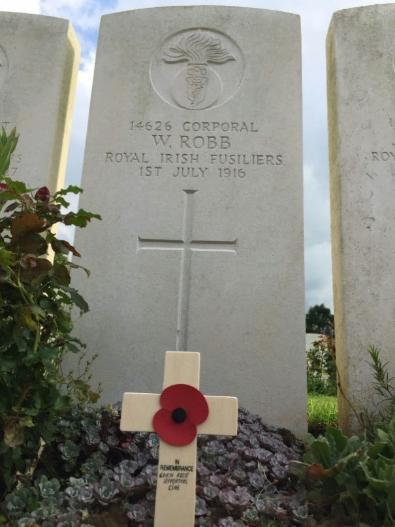
CWGC Grave of Corporal William Robb. Source: Author’s Collection
Private Alexander Hayes: Service Number 29/714, 2nd (Garrison) Battalion, Royal Irish Regiment
Alexander ‘Sandy’ Hayes lived at 21 Sarah Street, Portadown. He had previously served as Service Number 4792 with the Royal Irish Fusiliers. He died on 31st July 1918. His brother John had been killed on 1st July 1916 and another brother William, died on 12th October 1916. He is buried at the Longuenesse (St. Omer) Souvenir Cemetery in the Pas de Calais.
The Portadown News of 13th February, 1915 reported, “Private A. Hayes, Edgarstown, Portadown has arrived home suffering from shrapnel wound in the arm. He is a well known local footballer, and has come through several hot engagements."
The Portadown News of 4th May, 1918 reported, “Private Alexander Hayes, Sarah Street, who has been decorated with the Mons Star, has been granted a few days leave before proceeding to the front."
The Portadown Express of August 16, 1918 reported, “Private Alex. Hayes, Edgarstown, Portadown, has died in an overseas hospital. He was serving with the Royal Irish Fusiliers and held the Mons Star. He was a well known footballer and is the third member of his family to give his life for his country."
Sergeant-Major James Hughes, DCM, MM: Service Number 4517, 9th Battalion (North Irish Horse) Royal Irish Fusiliers
James was wounded in the face in October 1916. He was awarded the Military Medal for his actions in April/May 1917, during the fighting at the Chemical Works, Roeux. He was awarded the Distinguished Conduct Medal for gallantry under fire on 23rd March 1918, during the retreat from St Quentin, where he sacrificed himself.
The Portadown News on the 14th September 1918 reported:
Distinguished Conduct Medals
The King has been graciously pleased to approve of the award of Distinguished Conduct Medal to the undermentioned:
4517 Sergeant J. Hughes, M.M., Royal Irish Fusiliers, (Portadown). For conspicuous gallantry and devotion to duty. He went forward with a Lewis gun and knocked out an enemy machine gun, which was firing on our right flank. When his team were disabled, although wounded himself, he kept the gun in action until reinforcements came up.
James Hughes was the Son of John and Elizabeth Hughes, of 15 John St., Portadown and husband of the late Isabella Hughes. The CWGC date of death for James Hughes is recorded as 21st March, 1918, whilst another date of death is recorded by Nick Metcalfe as 23rd March, 1918
He is buried at the Roye New British Cemetery, Somme, France; Grave or Reference Panel Number: IV. B. 1.

Sergeant-Major James Hughes, DCM, MM. Source: Author’s Collection
Lance-Corporal William George Henry: Service Number 14276, 9th Battalion, Royal Irish Fusiliers
William George Henry resided at 89 Charles Street, Portadown. William Henry had signed for The Ports second eleven, The Commercials, in 1908 as a teenager. He spent the 1910-11 season with Portadown Celtic before re-joining Portadown Athletic FC.
He enlisted with many of his team mates in September 1914 and he initially was sent for training at Clandeboye camp in Bangor before moving to the Victoria Barracks in Belfast. The 36th Ulster Division left Ireland on the 1st and 2nd July 1915, headed for Seaford camp before setting sail for Le Harve on 4th October, 1915. William was reported missing on the 1st July 1916.
The Portadown News of 9th September 1916, reported, “Lance Corporal W.G Henry, Corcrain, who was reported wounded at the Battle of the Somme, is reported missing. Since July every effort has been made to trace him but in vain, and his wife and children still hope that he may yet turn up.”
From the Portadown News of 1st December 1917, came the sad news, “Mrs Henry, Corcrain, whose husband Lance-Corporal Wm. Henry, has been missing since 1st July 1916, has now received an official communication giving the number and describing the location of her husband’s grave.”
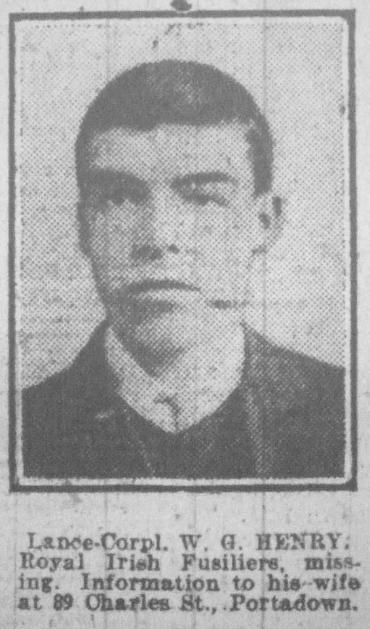
Portadown News, 1st December 2021. Source: Author’s Collection
Captain Philip Ernest Fairley(Fairleigh) DCM, MM: Service Number Unknown: 18th Battalion, London Regiment (London Irish Rifles)
Philip Ernest Fairley was formerly of West Street. Ernest as he was known was a teacher having taught at Water Street National School, Portadown and Principal of Annaghmore National School, before accepting as post with London County Council. As can be judged from the following reports Ernest gained rapid promotion through his heroic deeds.
The Portadown News of 4th December 1915 reported, “Sergeant Ernest Fairley, son of Mrs Fairley, Osbourne Terrace, has been promoted to the rank of Sergeant Major for gallant conduct in the field during the battle of Loos.”
The Portadown News of 1st July 1916 reported, Sergeant Major Fairley, who has won the D.C.M was well known in football circles, having assisted Portadown and Commercials on several occasions.”
The Portadown News, 21st October 1916 reported, “Sergeant Major P. Ernest Fairley of London Irish, who some time ago was awarded the D.C.M, for heroic service in the field, has been promoted to the rank of lieutenant.”
The Portadown News of 23rd Dec 1916 reported, “Captain Fairley, who won the D.C.M, was mentioned last week having been awarded the Military Medal.”
The Portadown News of 14th April 1917, “PORTADOWN OFFICER WOUNDED. Intimation has been received that Captain Ernest Fairley, D.C.M, has been wounded in action, and has been removed to England”
He was severely wounded in the back and spent a considerable time in hospital. Ernest died from his wounds at the Empire Hospital, London on 4th February 1919, and was buried from his mother’s house in Thomas Street, to St. Aidan’s, Kilmore.
His name appears twice on the Portadown War Memorial, as Fairley and Fairleigh.
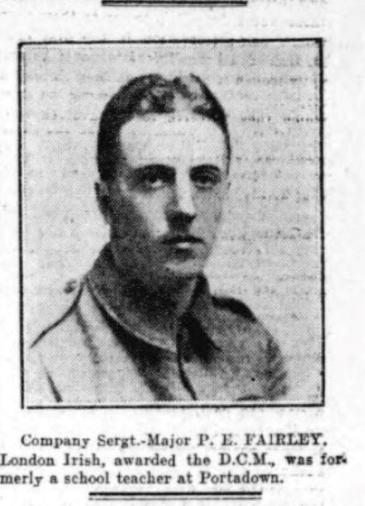
Portadown News, 1st July 1916. Source: Author’s Collection
The Injured
As well as those that paid the ultimate price the men of Portadown FC served bravely throughout the Great War. News continued to filter through from the front of Portadown players wounded in action. In September 1915, the Portadown Express reported that, “Private Joshua Jenkinson is officially reported to have been wounded in the fight for ‘Chocolate Hill’ at the Dardanelles. He was an enthusiastic footballer and often played for Portadown and the Commercials.” Over the ensuing years Private Jenkinson was regularly mentioned in the local press. In October 1917, the Portadown News reported “Private Joshua Jenkinson, West Street, Portadown, has been admitted to hospital in Salonika. He was severely wounded at the landing at Sulva Bay. In June 1918, another mention of Joshua advised us that he had been admitted to hospital in France and a month later came the news that he had arrived home from hospital having served in France, Palestine, Servia and Sulva Bay.
World War Two Roll of Honour
Corporal Joe Rooney: Service Number 4036188, 9th Battalion Gloucester
Three weeks after the 1941 Easter Tuesday attack, air-raid sirens went off again in Belfast. The skies were clear that night as around 200 German bombers approached the city in the early hours of the 5th May. Most of the bombs dropped on the harbour estate and Queen's Island found their target as, in a three-hour period, wave after wave of German planes flew overhead. However, many bombs did miss their target and destroyed streets in the city centre.
The raid ended around four o’clock in the morning and was regarded as a success by the Germans. They had hit most of their intended targets. A total of 191 people lost their lives in this attack including Joe Rooney.
The Portadown Times of Friday 13th June 1941 reported:
“It is now known that Joseph Rooney the Wolverhampton Wanderers centre half, whose name is on the Portadown retained list, was killed in an air raid in Belfast. Rooney, a soldier, signed for Portadown when he came to Northern Ireland in the middle of the season just ended, but owing to the fine form of George Black he was unable to find his place in the team. In peace time he was deputy to Stanley Cullis the English International centre half. His registration has been cancelled by the English Football League.”
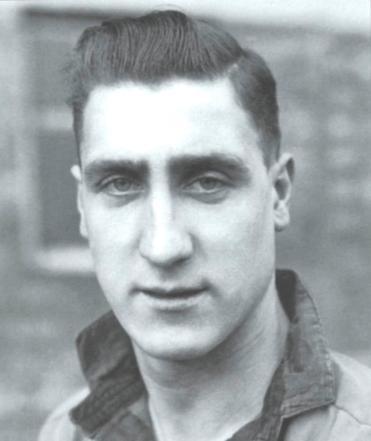
Joe Rooney. Source: Author’s Collection
Signalman Harry Kane: Service Number D/JX 165720, Royal Fleet Reserve
On the 21st June 1940, the Royal Naval Auxiliary vessel Prunella (HMS Cape Howe) was torpedoed in the Western Approaches as it sped to the rescue of another stricken vessel. On board the Prunella was Signalman Henry ‘Harry’ Kane. Harry was badly injured with shrapnel wounds to the head and chest. He was lifted onto a life raft but on the night of 21st/22nd June the life raft was overcome by severe weather conditions with 13 men on board. Harry had been a footballer with the famous old Edenderry Arrows FC and was trainer for Portadown FC in the first few years of their entry to senior football from 1924. He was also a qualified referee.
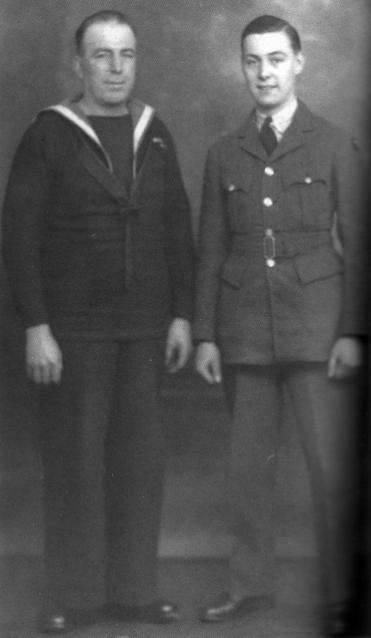
Harry Kane and his son James in 1940. Source: Author’s Collection
Pilot Officer Robert Montgomery: Service Number 170961, RAF Volunteer Reserve
Robert Montgomery was born in Enniskillen on 18th April 1922 and gained a scholarship to attend Sligo Grammar School across the border in Eire. It was there that he shone at rugby, winning recognition by the awarding of a junior provincial cap with Connaught. But he also excelled at football, and while home during the summer of 1937, he was spotted by Portadown playing for Armagh Whites in the Armagh Summer League. He returned to school in Sligo but the following summer he returned to Portadown where he scored a hat- trick in a trial game, after scoring 16 goals for Killylea in the Summer League.
The Ports snapped up the promising teenager and he made a scoring debut against Larne in a 4-0 victory at the start of the 1938/39 season. Leeds United manager Billy Hampson was at that match to run the rule of another Portadown player, William Black. It was Montgomery however who impressed more than Black, and Hampson switched his attention to the 5ft 10in, 12st, sixteen-year old amateur centre forward. The deal was sealed on 7th September 1938, when the Leeds United boss met with Ports manager Tommy Sloan and two of his directors at Ibrox Stadium in Glasgow where the Scottish League had been playing the Irish League that afternoon.
Robert never actually made a first team appearance for Leeds United, but he was s regular in the reserve team which finished runners-up in the Yorkshire League in 1938/39.
‘Monty’ enlisted on 23rd July 1941 joining, the RAF Reserves with the hope of becoming a pilot. He did much of his pilot training in Canada before returning to England for more training at Whitley Bay. After a posting to RAF Scampston, Robert was commissioned as a Pilot Officer, serial number 170961 in the RAF Volunteer Reserve on 14th January 1944.
He joined 49 Squadron and on 27th April 1944, flew his Lancaster crew on their 19th mission. The target was the ball bearing factories of Schweinfurt in Bavaria. The industrial units were a key part of the Nazi war machine, helping to build engines and generators for tanks. The raid was dangerous not helped by the bright moonlight that night. The mission was a failure, 21 Lancasters destroyed that same evening from a force of 215 Lancasters and 11 Mosquitos. The low-level marking provided for the first time by Mosquitos of No 627 Squadron was not accurate. Unexpectedly strong head winds delayed the Lancaster marker aircraft and the main force of bombers. German night fighters were carrying out fierce attacks throughout the period of the raid. The bombing was not accurate and much of it fell outside Schweinfurt.
As Robert and his crew were returning home over France, their Lancaster was shot down killing five of the seven-man crew including Robert. All five are buried beside each other in Bure Churchyard, Meuse, west of Nancy. Of the other members of the crew who parachuted to safety, Flight Sergeant John Baker was captured, while Sergeant Richard Mitchell evaded captured and with the help of French civilians he made his way through Switzerland and back to England.

Robert Montgomery. Source: Author’s Collection
Royal Ulster Constabulary Roll of Honour
Constable Robert ‘Roy’ Leslie, Royal Ulster Constabulary
On 18th September 1971, Robert (Roy) Leslie was murdered by Republican terrorists while on foot patrol with the Royal Ulster Constabulary in Strabane. A gunman got out of a car and opened fire on Roy and his colleague in the early hours of that fateful Saturday morning. He was just 20 years old. Roy had been on the books with Portadown FC prior to joining the RUC, gaining schoolboy international recognition. In the 1968-69 season he was a member of the Portadown Thirds team which won the Ulster Juvenile League.

Portadown Third Team, featuring Robert “Roy” Leslie. Source: Author’s Collection
As we remember their sacrifice their names will live on for evermore.
“Age shall not weary them, nor the years condemn. At the going down of the sun, and in the morning, we will remember them”
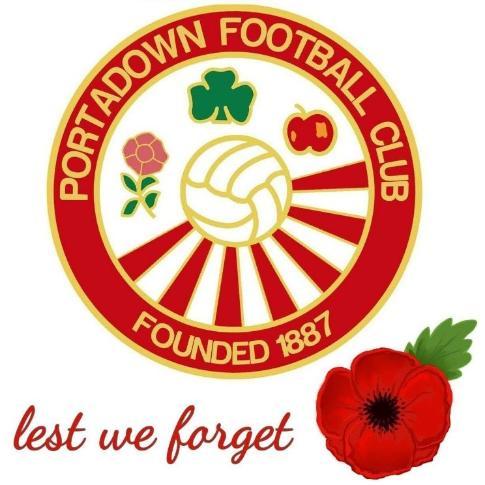
Biography
Trevor is currently the Media Officer and Club Historian for Portadown FC. He has been following Portadown FC in the Irish League for over 50 years. In 2004, he was appointed joint programme editor for the Portadown FC Matchday programme, “Ports in Focus”. His main passion in this role was to research and present the history of the club. It was always recorded that the club was founded in 1924, a date which featured on the club badge. From his research however, Trevor unearthed information which confirmed that the club was actually founded in 1887 and featured as a junior club until the Great War. The club badge now bears the date 1887.
Over the past number of years, Trevor has turned his attention to researching players associated with the club that have paid the ultimate sacrifice in service of the nation. In particular, he has presented to the club details of a number of players that were killed in action during the Great War. A particularly pleasing outcome is that the club now holds an annual remembrance service in November to commemorate those fallen heroes.
Trevor’s Second World War research produced information on Joe Rooney, who was signed from Wolverhampton Wanderers while on military service in Northern Ireland. It turned out that Wolves had actually recorded information on the wrong Joe Rooney in their records and as a result the club were able to put the record straight.
Trevor is always on the lookout for new information and in particular, photos of those players that laid down their lives. If anyone can assist with photos or contacts for information, please forward the details to Trevor at t.clydesdale@btinternet.com
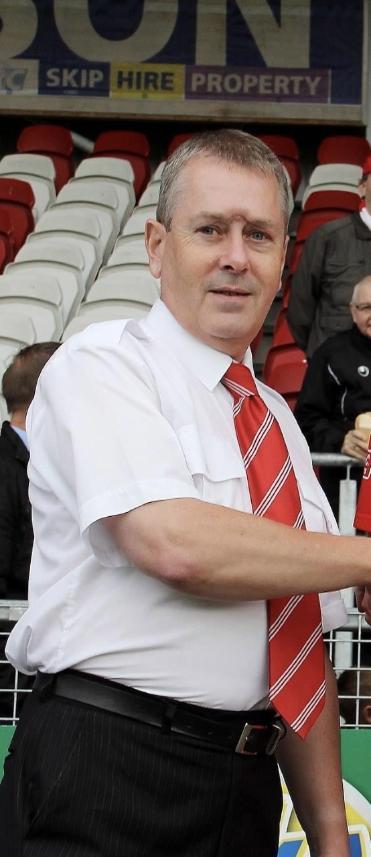


/prod01/wlvacuk/media/departments/digital-content-and-communications/images-2024/240624-Alumni-Awards-2024-Resized.jpg)
/prod01/wlvacuk/media/departments/digital-content-and-communications/images-18-19/220325-Engineers_teach_thumbail.jpg)
/prod01/wlvacuk/media/departments/digital-content-and-communications/images-2024/240627-UN-Speaker-Resized.jpg)
/prod01/wlvacuk/media/departments/digital-content-and-communications/images-2024/240320-Uzbekistan-Resized.jpg)
/prod01/wlvacuk/media/departments/digital-content-and-communications/images-2024/240229-The-Link-Resized.jpg)
/prod01/wlvacuk/media/departments/digital-content-and-communications/images-2024/240627-Lady-Aruna-Building-Naming-Resized.jpg)